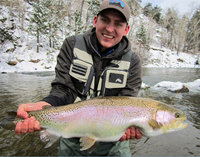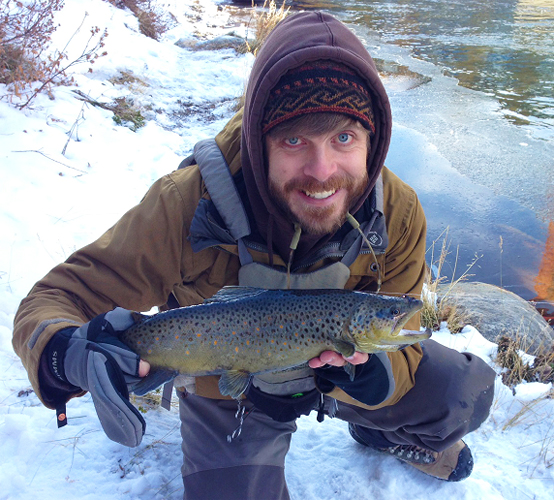Slow & Low: Winter Fly Fishing Tips & Tactics for Greater Success
Posted by Peter Stitcher on 2nd Dec 2015
First introduced to me by a fishing buddy and a transplant from the land of Dixie, the "Slow & Low" is made from a good rye whiskey seeped in orange peel and honey. Taking a nip off your flask when on the water in the winter helps to get the blood flowing in numb fingers and adds some warmth to wind-chapped cheeks. More important than acting as a dose of liquid fortification on a frosty day, the name of this drink acts as a good reminder of where we can expect to find trout in the winter and the best approach to landing sluggish fish.
As the mercury drops each winter and water temps hover just above freezing, trout evacuate their positions among the riffles and fast pocket water, and move to the deepest pools and slowest eddies in the river. Among the boulders and troughs that make up the bottom of the pools and eddies, trout find refuge from the energy-draining flows of the river, and remain almost motionless in an attempt to conserve energy. Not that different from the anglers who pursue them, when it's cold out - the trout move SLOW.
This is both a blessing and a curse for the fly fisher. While we get to attack the river with an economy of casts knowing that the fish are stacked up in the few deepest pools and eddies, the challenge is getting your flies deep enough and lining up your drift to get your flies in front of these lazy fish. Using tungsten bead heads and extra weight on your leader will help you to get slow & low, giving you the best chance at some winter action!
Make it a Double
The factors that typically affect water clarity in the warm months are runoff and the growth of algae in the water column brought on by long sunny days. In the winter, in addition to fish being stacked up on top of each other, winter waters are typically gin clear, making it difficult for the angler to approach the edge of the river, let alone drift their fly in front of a trout with anything less than a perfect cast without spooking the fish.
To combat the skittish nature of winter trout, try extending the length of your leader and paring down the weight. Ten or twelve foot leaders can give you just the right amount of reach to stretch out into these deep holes while remaining in the shadows along the bank, while dropping the weight down to 6x will cast a lighter profile making it less likely you will spook your prey.
Spark Their Interest
Long past are the days of juicy terrestrials, summer stoneflies, and swarms of caddis flies eclipsing the water. Instead, most of the food available to winter trout are invertebrates freshly emerged from their eggs, best matched by flies in sizes 20-28, and offering few calories to trout in compensation for their efforts to intercept drifting food.
In order to spark the interest of winter trout, try incorporating a heavy mix of attractor patterns into your winter fishing rigs. Flashbacks, fluorescents, metallic or colorful glass beads, and using blues and purples that are visible at greater depths and distances appeal to the predator nature of the trout.
Find the Hot Spots
While the water in winter tailwaters can be up to 10-15 degrees warmer than downstream portions of the river, being able to locate springs as they enter the river will allow you to find micro hotspots where fish are actively feeding. Unique among habitat types, springs maintain a nearly constant temperature year round. Bubbling up from the bottom of the river or traveling through the gravels of a seemingly dry upland creek bed, a spring can enter the river at an unseasonably warm 50+ degrees and drive trout to springtime levels of feeding activity.
Springs can be most easily identified in the winter as holes in the ice, and areas densely populated with trout. For the hardcore angler, bring a thermometer to the river and check the water temperature as you search for a hotspot.
You don't need to hang up your fly rod just because its winter! So stack on the layers, pack your flask, and head to the water for a little Slow & Low !



